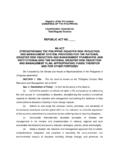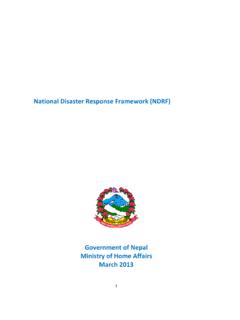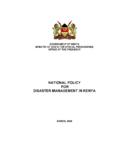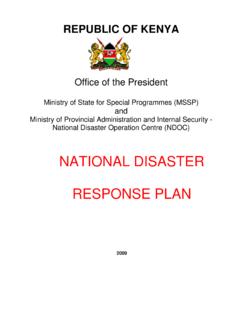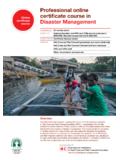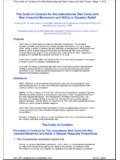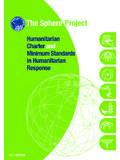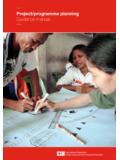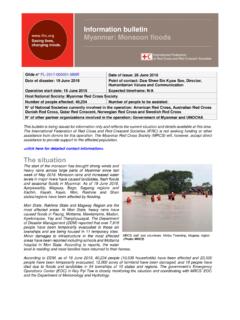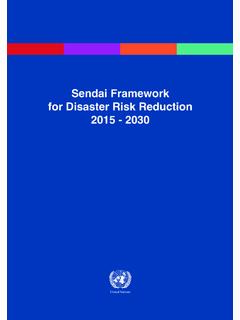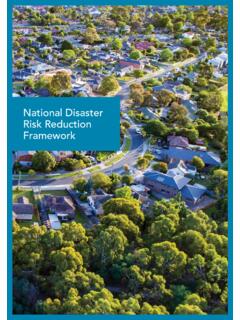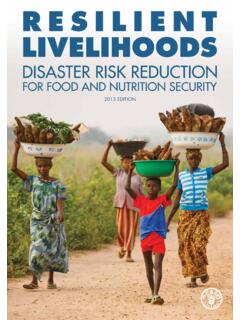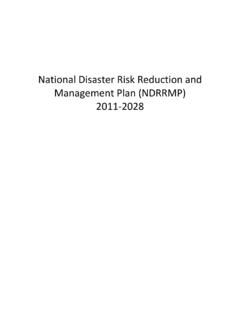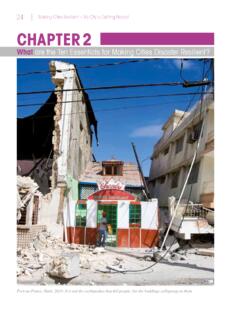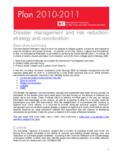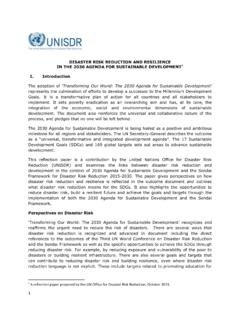Transcription of Disaster: how the Red Cross Red Crescent reduces risk
1 disaster : how the Red Cross Red Crescent reduces riskADisaster: how the Red CrossRed Crescent reduces riskThe International Federation s Global Agenda (2006 2010)Over the next two years, the collective focus of the Federation will be on a chieving the following goals and priorities:Our goalsGoal 1: Reduce the number of deaths, injuries and impact from 2: Reduce the number of deaths, illnesses and impact from diseases and public health 3: Increase local community, civil society and Red Cross Red Crescent capacity to address the most urgent situations of 4: Promote respect for diversity and human dignity, and reduce intolerance, discrimination and social prioritiesImproving our local, regional and international capacity to respond to disasters and public health up our actions with vulnerable communities in health promotion, disease prevention and disaster risk significantly our HIV/AIDS program-ming and our advocacy on priority humanitarian is-sues, especially fighting intolerance, stigma and dis-crimination, and promoting disaster risk reduction.
2 International Federation of Red Cross and Red Crescent SocietiesAny part of this handbook may be cited, copied, trans-lated into other languages or adapted to meet local needs without prior permission from the International Federation of Red Cross and Red Crescent Societies, provided that the source is clearly maps used do not imply the expression of any opinion on the part of the International Federation of Red Cross and Red Crescent Societies or National Societies concerning the legal status of a territory or of its authorities. Cover photo: Schoolchildren crouch under their desks in an earthquake-training programme in Palawan, Phil-ippines, early 2009. Rob Few/International Federation of Red Cross and Red Crescent Box 372CH-1211 Geneva 19 SwitzerlandTelephone: +41 22 730 4222 Telefax: +41 22 733 0395E-mail: site: : how the Red Cross Red Crescent reduces risk1A FEW countries around the world, more often than most but without too much injustice, are said to contain the best risk reduction success stories.
3 One is Bangladesh, where on 15 November 2007 Cyclone Sidr crashed ashore from the Bay of Bengal into the country s south-west coastal delta possi-bly the world s most heavily populated low-lying , a Category 4 when it made landfall, trig-gered tidal waves up to five metres high and even higher sea-surges, breaching embanked defences and causing floods and major very significant death toll, officially just over 3,400 with at least 1,000 missing, inevitably cast a pall over any celebration of the far larger number of lives saved through the disaster risk reduction (DRR) activities for which the country is now all-but forecasting and warning, reforestation, shelters and embankments produced, in the meas-ured language of the Bangladesh government s final report, lower casualty rates than would have been expected, given the severity of the storm.
4 The Bangladesh Red Crescent Society had mobi-lized thousands of volunteers along the stricken coast. Wearing their distinctive yellow waterproofs and equipped with only megaphones and drums, they evacuated hundreds of thousands just before Sidr s cyclone preparedness programme (CPP), run jointly by the government and the Red Crescent , now has 42,000 trained volunteers on its books, and there are well over 2,000 shelters available. It is as low tech as it gets: the CPP centres on pre-paring people for disasters by using community-based volunteers who do everything from street theatre to classes in schools to lectures for women s groups. The only high-tech aspect is the radios on which headquarters in Dhaka pass warnings to field the other side of the Indian Ocean from Bangladesh lies another of the world s most storm-wracked nations: Mozambique for the best part of a decade also a textbook example of highly success-ful, community-based, low-tech nearly 100,000 people were successfully evacu-ated, without compulsion and virtually without loss of life, in a flood emergency that affected an entire region, it would be on the evening news if it hap-pened in Europe or North America.
5 Yet this is exactly what happened in Mozambique at the beginning of 2008, the second year running the country suffered serious floods. And it went almost unnoticed and unreported in the outside world. It was an extraordinary feat for a post-conflict gov-ernment with few resources to draw on other than small boats, handheld VHF radios and Red Cross advances in Mozambique were inspired by a determination that the experience of the devastat-ing floods suffered in 2000, the worst in the coun-try s history in terms of losses, should never be repeated. That year saw one of the most intensively publi-cized climate related disasters ever, thanks to the ability of South African military helicopters to ferry western TV crews in and out of the flood zone from Maputo, from where they could satellite their pic-tures. But it was a very different story seven years later.
6 Even though floods in 2007 were also very large (judged by water levels), there were no deaths or injuries caused directly, according to Ana Cristina Joao Manuel of Mozambique s disaster -manage-ment institute. There were no major outbreaks of disease. In 2000 hundreds of people died. There was really a very big difference. A Cuban man bids farewell to a baby returning home from a shelter in the aftermath of Hurricane Ike in Pinar del Rio in September Daut/Reuters In 2000 hundreds died. There was really a very big difference disaster : how the Red Cross Red Crescent reduces risk2It shouldn t surprise anyone that the most widely talked-of examples of successful DRR involve rapid evacuations and (the media focuses on them to the exclusion of almost all other issues) dramatically reduced death-tolls. The consistently low hurricane death-tolls in Cuba are, of course, a reflection of its unique circum-stances, including a highly centralized government and well-developed civil defence, including a militia.
7 The way Cuba deploys its expertise at local level to help vulnerable communities, in particular, may have lessons for everyone. Cuba s example, it is argued, shows that protecting citizens from disaster is as much to do with political will and good organ-ization as material wealth. (Not to mention a respected Red Cross Society well able to play to the full its role as government auxiliary.) There are other examples, perhaps less spectacular and harder to measure: the stabilizing of river banks in Nepal; agricultural adaptation in drought peri-ods in Lesotho; land and water management by the five countries that share Africa s Lake Victoria; and the Cross -border preparedness system for the Nyiragongo volcano which is coordinated by the Rwandan Red Cross and the Red Cross of the Democratic Republic of the Congo. But what exactly is disaster risk reduction ?
8 Is it just anything that is not disaster response? DRR is now defined by the UN as reducing disas-ter risks (losses) through systematic efforts to ana-lyse and manage the causal factors of disasters, including through reduced exposure to hazards, lessened vulnerability of people and property, cor-rect management of land and the environment, and improved preparedness for adverse events .1 And what does it mean in Red Cross Red Crescent practice? Emergency evacuations are just one DRR activity the Red Cross Red Crescent carries out in the field-work to empower communities and make them resilient: Preparedness. A component of DRR, not a syno-nym for it. Warning. The Red Cross Red Crescent is work-ing on getting high resolution warnings, including those originating in satellite images or computer models, down to remote commu-nities that only volunteers have easy access to.
9 Mitigation. Education on how to avoid danger; concrete physical measures to limit the impact of disasters like the Vietnamese mangrove plan-tations which protect against storm surges. Recovery. A good example of DRR-minded recovery would be to build back safer after an earthquake. Livelihoods. Strengthening livelihoods, like veg-etable gardens that improve nutrition and increase reserves during droughts, helps house-holds reduce risk. Prepare, warn, mitigate, recover, live. DRR in the Red Cross Red Crescent world is multi-sectoral and part of a broad and long-standing drive for safer and more resilient communities. DRR is at the core of most National Societies work to address the specific vulnerabilities to which communities are ensure a common understanding of DRR within the Red Cross Red Crescent family and for the local people we work with, the Framework for Community Safety and Resilience was developed in 2008 after extensive consultation.
10 It s the foundation for all Red Cross Red Crescent action to build safer and more resilient the International Federation of Red Cross and Red Crescent Societies (International Federation) Global Alliance for disaster risk reduction, launched in late 2007, is initially being implemented by 20 National Societies2 worldwide, with a further 15 African societies3 involved in the International Federation s long-term food-security initiative. The intention is to increase that number each year for five years. This is all in response to the relatively new way of looking at traditional disaster management offered by DRR: the idea that the impact of disasters can A Mongolian Red Cross volunteer in May 2009 distributes livestock to help reduce the vulnerability of rural families affected by severe winter , warn, mitigate, recover, liveRob Few/International FederationDisaster: how the Red Cross Red Crescent reduces risk3be reduced by steps taken in advance, increasingly followed by early action.
